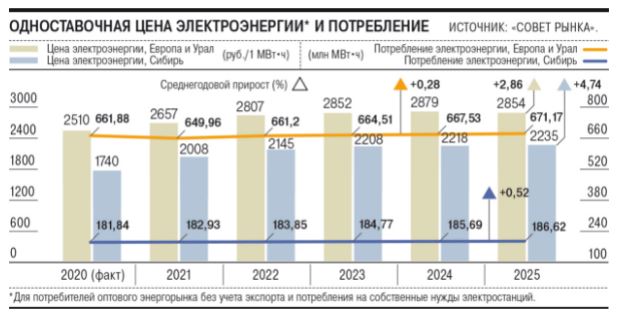Господдержка предприятий-производителей строительных материалов

The Market Council has updated the forecast for the dynamics of the cost of electricity for the industry, taking into account the collapse of consumption in 2020. The regulator expects the most noticeable price increases in 2021-2022. In the European part of the Russian Federation and in the Urals, they will grow by 6% for two years in a row. In Siberia, a 15% jump is expected this year, and a 7% jump next year. Then growth will slow down due to a decrease in payments for the capacity of new TPPs. But experts warn that after 2025 prices will go up again with the launch of new energy investment programs. Consumers talk about a decrease in the competitiveness of Russian products due to an increase in production costs, and the Ministry of Economy proposes mechanisms to limit the growth of energy prices.
The Market Council (the regulator of energy markets), at the request of the FAS, updated the forecast for wholesale energy prices until 2025, taking into account the last year's failure in electricity consumption (Kommersant has a letter from the FAS dated April 20, containing the forecast and responses from departments). We are talking about a one-rate wholesale price for industrial consumers (for the population, lower tariffs remain), consisting of a payment for capacity and the price of electricity. The indicator does not include network rates and sales margins, which are about half of the final price. The regulator refused to answer Kommersant's questions.

In the first price zone (the European part of the Russian Federation and the Urals), demand is expected to recover to the level of 2019 next year, and in the second price zone (Siberia) - already this year (see chart). Moreover, in 2021–2022, in both price zones, the one-rate price may rise above the forecasted inflation rate (about 4%). In Europe and the Urals in 2021, the indicator will increase by 5.87%, to 2.66 thousand rubles. per 1 MW • h, in 2022 - by 5.62%, to 2.8 thousand rubles. In Siberia, in 2021, the one-part price will grow by 15.39%, for the first time breaking through the ceiling of 2 thousand rubles, in 2022 - by 6.84%, to 2.15 thousand rubles.
In Europe and the Urals, the price jump will occur mainly due to an increase in non-market surcharges to the price of capacity for the construction of new TPPs in Kaliningrad, renewable energy sources and nuclear power plants, in Siberia - due to an increase in payments for the capacity of new TPPs built under capacity supply contracts (CSA ), and the price of competitive power take-off (PTO).
The prices for electricity in the wholesale market are formed by a competitive method, the increase in prices is mainly associated with the influence of surcharges to the cost of capacity, the FAS told Kommersant.
The Ministry of Energy told Kommersant that the increase in final prices (including the network tariff and sales markup) in Europe and the Urals in 2021–2022, according to Market Council estimates, is projected at about the inflation rate.
“The increase above inflation in 2021 in Siberia is partly due to the increase in the price of capacity, since during the 2021 CCM trading, some objects declared a high level of demand, which raised prices,” the Ministry of Energy clarified. the third power unit of the Berezovskaya GRES. The price of electricity and capacity will remain in the forecast parameters regardless of the growth in the price of the metal, which was reported by the generating companies ”.
The Ministry of Economy, according to the letter, proposes, for example, to freeze the volume of non-market surcharges in the price of capacity at the current year's level "by establishing a regular rate of return on invested capital at the OFZ + 2% level, reducing the calculated base of invested capital for the volume of budget investments, and reducing regional surcharges" ... The Economy Ministry did not respond to Kommersant's request.
“Considering that energy prices for industry have been steadily decreasing in recent years for Russia, in order not to finally lose its competitive advantage, it is advisable to reduce the tariff and price burden of the electric power industry on the economy according to the“ inflation minus ”principle, and not be limited by the inflation rate, as it is now”, - told "Kommersant" in the "Community of Energy Consumers" (unites large industry).
The Council of Energy Producers (EEC, which unites large generating companies) told Kommersant that “competitive segments of the energy market are built in such a way that they are guaranteed to hedge consumers from sharp price surges”. The PPA also noted that in the past year "we have repeatedly seen" forecasts "of a significant drop in energy consumption, as well as an increase in electricity and capacity prices," while in 2020 the growth of the one-part price did not exceed the inflation rate of 4.9%.
According to the forecast of the Market Council, after 2023, the growth of the one-part price will slow down due to the decrease in payments for the TPP CSA. However, after 2025, the rise in prices will accelerate due to the launch of new investment programs in the energy sector, in particular the modernization of old thermal power plants, believes Sergey Rozhenko from KPMG. Thus, in Europe and the Urals, the average annual growth rate will be 4.7%, and the one-part price will reach 3.8 thousand rubles. for 1 MW • h by 2030, the analyst believes.
Source: https://www.kommersant.ru/